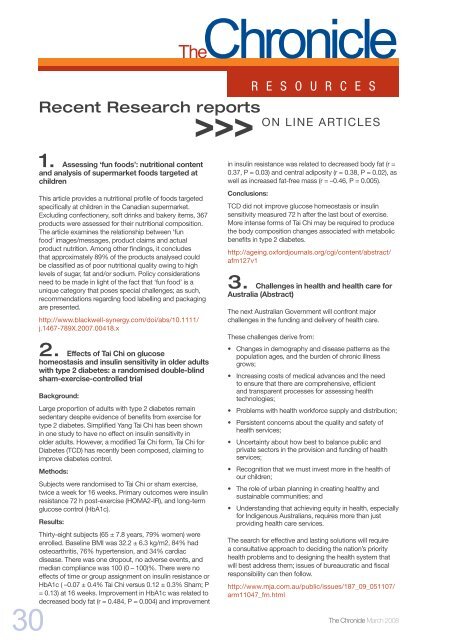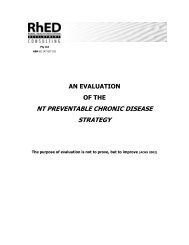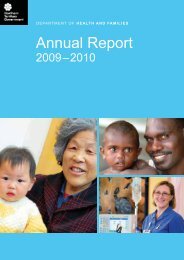Chronicle - March 08.pdf - DHCS Digital Library
Chronicle - March 08.pdf - DHCS Digital Library
Chronicle - March 08.pdf - DHCS Digital Library
- No tags were found...
You also want an ePaper? Increase the reach of your titles
YUMPU automatically turns print PDFs into web optimized ePapers that Google loves.
The <strong>Chronicle</strong>R E S O U R C E SRecent Research reports>>>ON LINE ARTICLES1. Assessing ‘fun foods’: nutritional contentand analysis of supermarket foods targeted atchildrenThis article provides a nutritional profile of foods targetedspecifically at children in the Canadian supermarket.Excluding confectionery, soft drinks and bakery items, 367products were assessed for their nutritional composition.The article examines the relationship between ‘funfood’ images/messages, product claims and actualproduct nutrition. Among other findings, it concludesthat approximately 89% of the products analysed couldbe classified as of poor nutritional quality owing to highlevels of sugar, fat and/or sodium. Policy considerationsneed to be made in light of the fact that ‘fun food’ is aunique category that poses special challenges; as such,recommendations regarding food labelling and packagingare presented.http://www.blackwell-synergy.com/doi/abs/10.1111/j.1467-789X.2007.00418.x2. Effects of Tai Chi on glucosehomeostasis and insulin sensitivity in older adultswith type 2 diabetes: a randomised double-blindsham-exercise-controlled trialBackground:Large proportion of adults with type 2 diabetes remainsedentary despite evidence of benefits from exercise fortype 2 diabetes. Simplified Yang Tai Chi has been shownin one study to have no effect on insulin sensitivity inolder adults. However, a modified Tai Chi form, Tai Chi forDiabetes (TCD) has recently been composed, claiming toimprove diabetes control.Methods:Subjects were randomised to Tai Chi or sham exercise,twice a week for 16 weeks. Primary outcomes were insulinresistance 72 h post-exercise (HOMA2-IR), and long-termglucose control (HbA1c).Results:Thirty-eight subjects (65 ± 7.8 years, 79% women) wereenrolled. Baseline BMI was 32.2 ± 6.3 kg/m2, 84% hadosteoarthritis, 76% hypertension, and 34% cardiacdisease. There was one dropout, no adverse events, andmedian compliance was 100 (0 – 100)%. There were noeffects of time or group assignment on insulin resistance orHbA1c ( –0.07 ± 0.4% Tai Chi versus 0.12 ± 0.3% Sham; P= 0.13) at 16 weeks. Improvement in HbA1c was related todecreased body fat (r = 0.484, P = 0.004) and improvement30Thein insulin resistance was related to decreased body fat (r =0.37, P = 0.03) and central adiposity (r = 0.38, P = 0.02), aswell as increased fat-free mass (r = –0.46, P = 0.005).Conclusions:TCD did not improve glucose homeostasis or insulinsensitivity measured 72 h after the last bout of exercise.More intense forms of Tai Chi may be required to producethe body composition changes associated with metabolicbenefits in type 2 diabetes.http://ageing.oxfordjournals.org/cgi/content/abstract/afm127v13. Challenges in health and health care forAustralia (Abstract)The next Australian Government will confront majorchallenges in the funding and delivery of health care.These challenges derive from:• Changes in demography and disease patterns as thepopulation ages, and the burden of chronic illnessgrows;• Increasing costs of medical advances and the needto ensure that there are comprehensive, efficientand transparent processes for assessing healthtechnologies;• Problems with health workforce supply and distribution;• Persistent concerns about the quality and safety ofhealth services;• Uncertainty about how best to balance public andprivate sectors in the provision and funding of healthservices;• Recognition that we must invest more in the health ofour children;• The role of urban planning in creating healthy andsustainable communities; and• Understanding that achieving equity in health, especiallyfor Indigenous Australians, requires more than justproviding health care services.The search for effective and lasting solutions will requirea consultative approach to deciding the nation’s priorityhealth problems and to designing the health system thatwill best address them; issues of bureaucratic and fiscalresponsibility can then follow.http://www.mja.com.au/public/issues/187_09_051107/arm11047_fm.html<strong>Chronicle</strong> <strong>March</strong> 2008
















